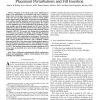Free Online Productivity Tools
i2Speak
i2Symbol
i2OCR
iTex2Img
iWeb2Print
iWeb2Shot
i2Type
iPdf2Split
iPdf2Merge
i2Bopomofo
i2Arabic
i2Style
i2Image
i2PDF
iLatex2Rtf
Sci2ools
TCAD
2008
2008
Chip Optimization Through STI-Stress-Aware Placement Perturbations and Fill Insertion
Starting at the 65-nm node, stress engineering to improve the performance of transistors has been a major industry focus. An intrinsic stress source--shallow trench isolation (STI)--has not been fully utilized up to now for circuit performance improvement. In this paper, we present a new methodology that combines detailed placement and active-layer fill insertion to exploit STI stress for performance improvement. We conduct process simulation of a 65-nm production STI technology to generate mobility and delay impact models for STI stress. We then utilize these models to perform STI-stress-aware delay analysis of critical paths using Simulation Program with Integrated Circuit Emphasis (SPICE). We present our timing-driven optimization of STI stress in standard cell designs, using detailed placement perturbation and active-layer fill insertion to improve complementary metal
| Added | 15 Dec 2010 |
| Updated | 15 Dec 2010 |
| Type | Journal |
| Year | 2008 |
| Where | TCAD |
| Authors | Andrew B. Kahng, Puneet Sharma, Rasit Onur Topaloglu |
Comments (0)

